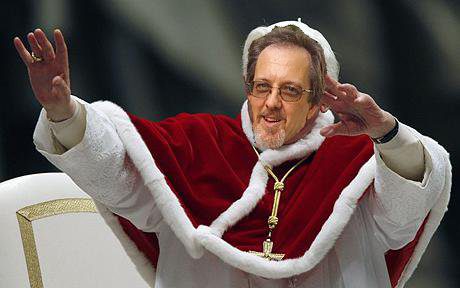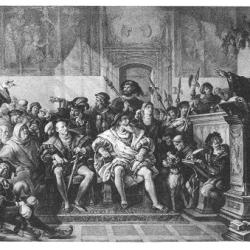Original title: “I’m a Catholic Largely Because of Vatican II”

Satirical photograph of yours truly: created by anti-Catholic Protestants in order to mock me. And so I’ll use it to poke fun at myself.
***
(4-25-14; expanded and re-edited: 1-23-17)
***
[words of Catholic journalist Jay McNally will be in blue; see the original Facebook exchanges for the fuller debate; I have edited and condensed it a bit for this post]
***
I was challenged by a Catholic friend who took the directives of Vatican II seriously about sharing the faith with separated brethren in a way that they can understand. If I had talked to radical Catholic reactionaries instead back in 1990, they would have moaned and groaned about the Church and it would have had zero appeal to me, as I was already quite happy and content as an evangelical Protestant.
While they bashed the Church, my friend loved Vatican II and defended and loved Holy Mother Church. The so-called “traditionalists” (i.e., what the radical reactionaries try to call themselves, over against legitimate Catholic traditionalists) acted like Protestants or liberal dissidents, and the so-called “neo-conservative” or “neo-Catholic” or “Novus Ordo Catholic” acted like a Catholic (follows the Church, pope, and Councils). It’s, um, called the “magisterium”. Duh!
The first issue I changed my mind about was contraception, and the Church’s prohibition of it was reiterated by the pope who closed Vatican II: Blessed Pope Paul VI in Humanae Vitae in 1968.
The other great issue for me was the development of doctrine, after reading Blessed John Henry Cardinal Newman’s essay on that topic. He is considered the “Father of Vatican II” and stressed lay participation and the sensus fidelium. I was a lay missionary then and a lay Catholic apologist now (another emphasis of Vatican II).
My mentor was Servant of God, Fr. John A. Hardon, S. J., who was a close adviser to Blessed Pope Paul VI and also to St. Teresa of Calcutta (Mother Teresa): who was first brought to wide attention by Malcolm Muggeridge (another convert) in his 1971 book, Something Beautiful for God. Muggeridge was one of the few Catholics and apologist-types with whom I was familiar before 1990 (also somewhat with Chesterton). He converted largely due to the contraception issue.
So if someone is looking for me to protest against the upcoming canonizations [of Pope St. John XXIII and Pope St. John Paul II], and say false and slanderous things about the Church and the two popes, they’re barking up the wrong tree. I love Vatican II, and I love these two popes who are about to be canonized (and have defended one of them many times).
*****
Dave, but if you are saying contraception and Muggeridge, Fr. Hardon and M. Teresa were exemplars for you, then you are making the traditionalist argument. Muggeridge was persona non grata, as was/is Fr. Hardon to the “Spirit of Vatican II” crowd. From what I can see, the vast majority of “traditionalists” do not despise Vatican II, but hate what came out of it, and at the top of that list was the conscience clause that was preached virtually in all parishes, especially by bishops. The only newspaper Hardon read regularly was The Wanderer.
I have affinities with “traditionalists” in many ways, as I have often noted. I have no affinity whatsoever with radical Catholic reactionaries. I deny that all this junk “came out of” Vatican II. That’s a false premise. It came from liberalism and the secularizing cultural chaos of the 60s, whereas VII was entirely orthodox and in line with Tradition.
Dave, if what you are saying is correct, what was Ratzinger talking about all those years?
A false application and corruption of Vatican II, of course. He argued that it is in strict continuity with the past and has the same authority as Trent (The Ratzinger Report).
Dave, your commentary raises interesting questions. Just who should any Catholic believe? People like you, who are not ordained and have no (as far as I know, no advanced degrees or formal eduction in philosophy or theology), or bishops and ordained priests, many of whom have Ph.Ds or the equivalent in theology from pontifical universities?
I am believed to the extent that I am backed up by official Church documents and priests and bishops of that Church. I’ve been through this a hundred times. I have Fr. Hardon’s Foreword for my first book. I have several imprimaturs (including from my own bishop) for various books and a pamphlet. I’ve been associated with many groups that have massive backing by bishops (Coming Home Network, Catholic Answers, etc.). I have been published by publishers who have that same support from the Church (Sophia, OSV, CA). I’ve been on many radio shows with such support (EWTN affiliates, etc.) I have lots of priests as friends on Facebook.
I’ve never been censured a single time for anything I have written online or in a book, as being unorthodox. On a few occasions I realized I was mistaken on relatively minor points and changed them. I back myself up with magisterial documents. If I am to be shown to be heterodox, it has to come from those same sources.
I’ve been through the canard about education many times, too. Chesterton had no degree at all, let alone theological education. C. S. Lewis was an English professor, as is Thomas Howard. Chesterton and Muggeridge were journalists. Frank Sheed and Karl Keating were lawyers. Peter Kreeft is a philosophy professor. I majored in sociology. The most effective and well-known and influential apologists are almost all lay and educated in other fields. But throw up the silly objection. I’ve answered it a hundred times before. Why not a 101st time?
If you pay me, I’ll spend time tracking down the official statements from bishops and theologians who made all sorts of claims that are contrary to the CCC (pre-1994) and said this (what you call “junk”) was the new thinking of the Church.
Priests and theologians have to be checked to see if they line up with what the Church teaches, too. Thank God we have that ability as Catholics, to know what the magisterium teaches. Being ordained or having theological degrees is no guarantee of orthodoxy at all. That was true of virtually every major heretic in history.
This “junk” was the main teaching of whole diocese, from top to bottom, for at least 20 years.
Well, now we have the Catechism of the Catholic Church; we have massive apologetics and catechetical efforts, including online, so why live in the past?
Normal people can’t possibly keep up with the fine points of theology and they should not be expected to. The chaos following Vatican II came from Rome and was sanctioned by the vast majority of the hierarchy. Even as a 15-year-old at the high school seminary I could identify a lot of it as pure bs, but had no standing against the priests and bishops who taught the “junk.”
Exactly! Thanks for backing up my point. Case closed!
There was a decline in the Church from the close of the Council that has not stopped.
It has been stopped. Things are improving now. Every revival has to start with things still being pretty bad. But it doesn’t follow that no good things are happening, just because lots of garbage remains to be cleaned out.
If you don’t exercise faith and take the long view all you will see are bad things. But if you look back at past revivals, you can see that another is coming in the future, just as it always has in Church history; so you exercise faith and get beyond the gloom-and-doom, “oh woe is us” mentality. You get off your butt and decide to be part of the forward progress; to do something about it. You know that is what I’m doing. Yet I have to defend myself on this elementary level with you.
So, the bitterness that will linger for another 100 years from the faithful
Faithful people don’t linger in bitterness for 100 years or even 100 minutes. They have faith! They are fundamentally optimistic, while acknowledging real problems. They do something about them with their lives, rather than merely sit and condemn all day long. If you want to sit and be bitter and complain and moan your whole life, Jay, you are welcome to do so. That’s not my life.
. . . was indeed created by the Church and is part of Vatican II.
Absolutely not. It was created by liberals in the Church but not by the council at all.
If you accept the concept of the “sensus fidelium” you have to ponder that maybe the hundreds of millions of faithful who walked out and continue to walk out have something correct in their understanding that something is not right. To summarize: The highest levels of the Church embraced all manner of what you call “junk” and said it was part of Vatican II. The “trads” never bought any of it. To try to separate the legacy of Vatican II from the council itself defies logic.
That’s nonsensical thinking. The sensus fidelium is in line with previous tradition (as in, e.g., the Arian crisis which was Cardinal Newman’s example he used for this principle). It’s never in line with tradition to become schismatic and leave the Church. That’s the liberal and the Protestant method of dealing with problems in the Church. The Catholic method is to stay (one sinner among a multitude of sinners) and reform, with the help of God’s grace.
If someone leaves the Church, they are either greatly confused or have lost the supernatural virtue of faith: particularly in the indefectibility of the Church. The problem ultimately lies with them, not with the magisterium. They are correct that there are problems in the Church (just as Luther was), but they are incorrect on how to solve them, and also in identifying them properly.
So we see that confusion in your own outlook. You are gloom and doom. That’s a lack of faith that God can reform and renew His Church. You blame Vatican II, which is dead-wrong. You think [in partially justifying those who leave] that leaving the Church is some kind of “solution.” It never has been. St. Augustine thought that schism was among the greatest of all sins.
Dave, I do not think “leaving the Church” is a solution and never did. But I have eyes: Many did leave, and stats tell us that the vast majority who still call themselves Catholic don’t believe or accept our core moral principles. It is a situation that was created by Vatican II and I don’t see much of a rebound, indeed the culture is collapsing across the board.
A major argument has been that the “seeds” had been sown decades earlier, and Vatican II was the resulting mix of bad theology/philosophy/politics; it was the creation of “liberals.” Much has been written on this point. I was an altar boy in the Tridentine era and after Vatican II. There was no “continuity” whatsoever, it was literally a black/white transition into a new Church, and I was baffled to see priests so easily change their perspective, seemingly overnight. My big introduction to Vatican II was at about age 13 or so when the vestments for funerals went from black to white, literally. Instead of a heavy black cloth draped over the coffin, it was now white, with flowers embroidered on it, and the standard funeral song, Mozart’s “Requiem,” was replaced by “The Strife is Over …” and eventually Ray Repp’s “Allelu, Allelu…everybody sing Allelu.” And the sermons went from praying that the dead guy get out of purgatory, to praying to him/her because he was now in heaven. I just don’t see how 30 years of that can be dismissed as a bad interpretation of solid theology by 90 percent of the bishops running the show. Those who question/reject Vatican II say it was bad theology interpreted by bishops/priests who were trying to follow orders and do the right thing, in union with Rome.
You appear to be quite unfamiliar with analogous Church history then, Jay. Most of even the Western bishops (minus the pope) went astray during the Arian crisis, even though the Council of Nicaea had already settled the question. The East went almost entirely astray, as Newman noted in his Essay on Development. Likewise, we see the wholesale defection of the bishops in England during Henry VIII (though under threat of death). Only St. John Fisher held firm.
Chesterton noted that the Church has gone to the dogs five times, and in every case, the dog died. It will again in this instance. The liberal generation will mostly die out in the next 20 years. They had their “fun” and wreaked havoc. Now they will go into the dustbin of history with all the other heretics. I can see this clearly. So could Fr. Hardon, who often said that “the worst centuries in history were always followed by centuries of revival.” We’re in that century. Revival is coming, for those who have the eyes of faith to see it. You don’t seem to be able to. I can, by God’s grace, and by knowledge of similar events many times throughout Church history.
It’s a sad thing to lose hope and faith. If you pray to God, you can get it back. All’s not lost.
And finally (for today), Dave it is correct that one shouldn’t walk away, and I have not walked away. But, it is the fight by the “trads” and the “radtrads” [those whom I call “reactionaries”] that have moved the Church off the bad trajectory. For example, approval of the Latin Mass — Benedict’s decree several years ago — came due to pressure from SSPX and the conservative factions that just don’t go along with the “junk.” The first Tridentine Mass in St. Peter’s Basilica since Vatican II was said in the last year or so. So, I don’t think it makes good sense to say that it was “liberals” who misinterpreted Vatican II that refused to allow the historic Mass to be said at St. Peters. It was led by a bunch of popes (Paul IX, JPI, JPII, Benedict) who were following the Vatican II line that the Tridentine Mass was dead, on the trash heap of history. Benedict forced the issue and said Vatican II (or its interpreters for 45 years) was wrong: the Tridentine Mass is part of the Church and always will be. It is a fair and honest discussion how/why the bad things happened if Vatican II was 100% correct.
Wrong again. As Karl Keating recently opined (quite plausibly), the “traditionalists” in the 80s set the movement back twenty years by going ga-ga over Abp. Lefebvre and adopting a reactionary stance, by and large.
That’s what got bishops thinking they were a fringe and a bunch of fanatical quasi-schismatics (which many of them were: I dealt with them from 1997 on). I agree with you that the Old Mass should have always been available. I think the behavior of the older generation of traditionalists is in part responsible for it not being available through those years. I’ve always been in favor of it being available, since I converted in 1990, which is why I attend St. Joseph’s.
Who brought it back? Pope St. John Paul II (whom reactionaries despise) first made it more widely available, and then Pope Benedict XVI in a more sweeping way. They are both quintessentially men of Vatican II.
Pope Benedict, the traditionalist’s darling (also the fave of many radical Catholic reactionaries) did not (oddly enough!) take away the Novus Ordo [Ordinary Form Mass], did he? The reactionaries loved him for making the Old Mass [Extraordinary Form] available universally (in theory), but they also like to ignore the fact that he also taught that both Masses were forms of the one Latin / Roman Rite. As usual, it’s an arbitrary pick-and-choose (always the schismatic and heretical tendency).
I wrote about this recently in dialogue with people who were giving up on the reform of the reform. They will cite Benedict regarding the Old Mass, from 2007, but when they cite him talking about the New Mass, it’s almost always (to me, comically) drawn from a few over-used critical comments, pre-pope (particularly, the famous “banal” quote).
Fr. Angelo Geiger of the Mary Victrix site (who performs the TLM) has recently shown that even those comments are massively misinterpreted by those who cynically use them. I have that info. on my site.
In the “Benedictine era,” the quasi-schismatic kooks among the radical Catholic reactionaries shut up quite a bit, and many of them became respectable mainstream traditionalists: which is why I am now careful to identify and distinguish two completely different groups.
Hopefully, the worst of them will depart and spread their errors elsewhere (and mind their own souls, which are in grave danger), and we can get back to the business of being Catholics and following Holy Mother Church, minus their endless ignoramus cackling and bellyaching and creation of divisions, to the devil’s great delight.
















